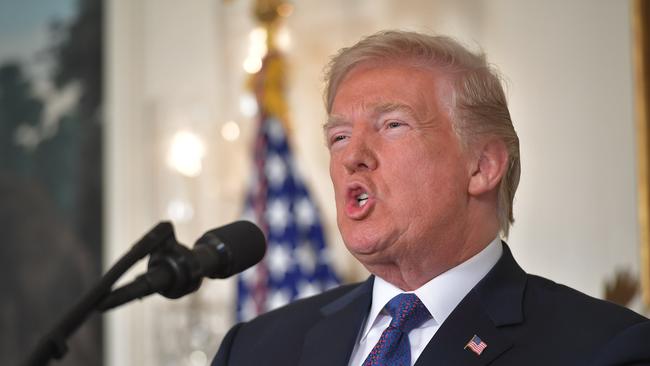US-China deal hard to imagine
China hawks in the US administration have long seethed over its industrial policy and it’s naive to hope for a quick deal.

After weeks spent threatening tariffs on an ever-greater share of Chinese imports, US President Donald Trump seems to be in a more conciliatory mood. On April 10 a speech by Chinese President, Xi Jinping prompted him to tweet a prediction: “We will make great progress together!”
Many besides Mr Trump share that hope. If China offers him a deal that he is willing to sign, a trade war may still be averted. Or sense may prevail, as it did last month, when American allies such as Canada and Mexico were exempted from tariffs on steel and aluminium. But such optimism shades into naivety. China hawks in the American administration have long seethed over aspects of the relationship with China that rarely feature on Trump’s Twitter feed. Those problems predate his presidency. And they do not look easy to resolve.
The rules-based system of international trade works best for problems that are clearly defined, and when it is easy to judge the success or failure of a remedy. Tariffs, and laws that discriminate against foreign firms, are classic examples. Some of the Trump administration’s gripes with China, published in a 182-page report on March 22, fall into this category. (The report was the result of an investigation into China’s trade practices under Section 301 of the Trade Act of 1974).
For example, it claims that Chinese law discriminates against American companies by undermining their freedom of contract in several ways. Chinese firms can negotiate with each other over the terms of technology licensing agreements, but foreign licensees must bear all the risk of others suing for intellectual property infringements.
Joint ventures must grant the Chinese partner the right to use the foreign partner’s technology even after their agreement has expired. Such complaints will be considered by the World Trade Organisation and judged against the commitments China made when it joined in 2001.
But resolving other gripes will be harder — whether in the WTO or as part of a bilateral deal. Some are not to do with China’s written laws, but with its unwritten rules and informal procedures. Upon joining the WTO (and a further eight times since 2010) China pledged not to make handing over technology a condition for market access. But the Americans say Chinese officials continue to pressure firms to do so.
Such a claim is hard to prove — all the more so given the opacity of China’s regulatory processes. And experience suggests that any deal would be devilishly difficult to enforce. The Chinese authorities can say that contracts involving technology transfer were signed voluntarily. They can make life hard for any foreign company that dares say otherwise.
Robert Atkinson of the Information Technology and Innovation Foundation, an American think tank, accuses the Chinese of playing rope-a-dope, allowing the American administration to exhaust itself in ultimately futile complaints. He thinks that it should give up on the rules and focus instead on results, for example by arranging for American firms to inform it “off the record” of Chinese infractions. But any such flexible arrangement would be fiercely resisted by the Chinese.
Half of the Section 301 report concerns Chinese investment in America. The Americans take issue with Chinese firms’ acquisitions of American ones, such as Lexmark, a printing company, in 2016, and Mattson Technology, which produces equipment for making semiconductors, in 2015.
In both cases the purchase price was well above market value. The Chinese maintain that these were fair transactions on the free market; the Americans suspect that they were directed and supported by the Chinese government in a bid to dominate strategic sectors. Any mutual agreement to curb such purchases would have to outline a legitimate role for the state. But China’s model of state-directed capitalism makes it hard to distinguish between public and private affairs.
At the heart of the disagreement is China’s industrial policy. The Americans suspect the Chinese government of enticing their firms with the promise of a vast consumer market, only to use regulatory pressure to strip them of their bargaining power and expose them to the theft of intellectual property by forcing them into joint ventures. They spy a plot to undercut and eventually surpass American industry.
The Section 301 report relays the story of SolarWorld, a maker of solar panels that claims its trade secrets were stolen. The result was that cheap Chinese competitors flooded the market, costing it more than $US120 million ($155m) in sales and revenue. The Americans worry that unless the Chinese government changes its ways, other American industries will soon lose out to China, too.
But what the Americans see as unfair the Chinese see as the path to development. From their point of view, bringing in American firms is a roaring success. A study analysing joint ventures in China in 1998-2007 found that they boosted both the Chinese partner and the industry in which it was active. Ventures with American firms were more fruitful than those with firms from Hong Kong or Japan.
During his speech this week, Xi repeated old promises to cut tariffs and relax investment restrictions in some sectors. The American vision is of more sweeping change. According to Bloomberg, secret bilateral talks broke down after the Americans demanded an end to Chinese subsidies for hi-tech industries. It is hard to imagine a deal that reconciles these fundamental differences.
That leaves a choice — between an agreement that is shallow and fragile, or conflict.
The Economist



To join the conversation, please log in. Don't have an account? Register
Join the conversation, you are commenting as Logout